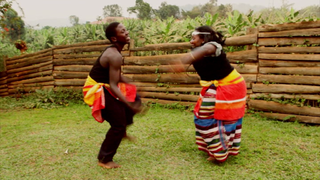Related Research Articles

Bunyoro, also called Bunyoro-Kitara, is a traditional Bantu kingdom in Western Uganda. It was one of the most powerful kingdoms in Central and East Africa from the 13th century to the 19th century. It is ruled by the King (Omukama) of Bunyoro-Kitara. The current ruler is Solomon Iguru I, the 27th Omukama.

Ankole was a traditional Bantu kingdom in Uganda and lasted from the 15th century until 1967. The kingdom was located in south-western Uganda, east of Lake Edward.

Mbarara District is a district in South Western Uganda. In 2019, the Ugandan Cabinet approved part of Mbarara District, the then-Mbarara municipality, to be upgraded to city status effective July 2020.
The Hororo or Bahororo are a Bantu-speaking ethnicity mainly residing in the north of the former Kigezi District in southwestern Uganda. In 1905, they were described by a British officer as a "quiet, inoffensive people" who owned cattle. They are made up mostly of the Hima ethnic group and the Iru ethnic group. They reside mainly in Rujumbura in southwestern Uganda and are related to the Banyankole, Banyoro, Batooro, Songora and Tutsi peoples respectively. Rujumbura was ruled by the BeeneKirenzi sub-clan with Omukama Karegyesa as their last king. The Bahororo speak a dialect of Nkore-Kiga, Ruhororo. They are subdivided into clans that are similar to those of the kingdom of Ankole. Unlike Ankole, which was ruled by the Hinda clan, Mpororo was led by the Bashambo clan.

Uganda is divided into :

The Uganda Museum is located in Kampala, Uganda. It displays and exhibits ethnological, natural-historical and traditional life collections of Uganda's cultural heritage. It was founded in 1908, after Governor George Wilson called for "all articles of interest" on Uganda to be procured. Among the collections in the Uganda Museum are playable musical instruments, hunting equipment, weaponry, archaeology and entomology.
The Kingdom of Igara traces its origin from the Kingdom of Mpororo in southwest Uganda. Igara is now the name of a county in Bushenyi District, surrounding the town of Ishaka.
Obwera was one of the six independent kingdoms in present-day Uganda which were established after the fall of the Kingdom of Mpororo in 1752. It was ruled by an Omukama. It became a part of the Kingdom of Ankole in 1901.
Kajara was one of the six independent kingdoms which was established after the fall of the Kingdom of Mpororo in 1752. It was ruled by an Omukama. It became a part of the Kingdom of Ankole in 1901.
Rujumbura was one of the six independent kingdoms which was established after the fall of the Kingdom of Mpororo in 1752 in present day Rukungiri, south western Uganda. It was ruled by an Omukama from the Beene Kirenzi sub-clan of the Bashambo.
The Nkole people also known as the Banyankole, are a Bantu ethnic group native to the Ankole region of Uganda. They are primarily found in the southwestern part of the country, in what was historically known as the Ankole Kingdom. The Banyankole are known for their rich cultural heritage and traditional cattle-keeping practices. They are closely related to other Bantu peoples of the region, namely the Nyoro, Kiga, Toro and Hema people.

Mitooma District is a district in Western Uganda. It is named after its main municipal, administrative and commercial center, Mitooma.

Bweranyangi Girls' Secondary School is a girls-only boarding middle and high school in Bushenyi District in the Western Region of Uganda.

The Tooro people, also known as Batooro or Toro people are a Bantu ethnic group, native to the Tooro Kingdom, a subnational constitutional monarchy within Uganda.
Biharwe is a neighborhood within Mbarara City
Isaac Mulindwa is a businessman and former politician in Uganda. He is the founder and owner of Makinawa Motors Limited, an automobile dealership based in the Kololo neighborhood in Uganda's capital, Kampala.

Basil Kiiza Bataringaya was a prominent Ugandan politician in post-independence Uganda. He was the Leader of the Opposition at the beginning of the Apollo Milton Obote government, and then he changed parties and was appointed to the powerful role of Ugandan Minister of Internal Affairs. He was imprisoned, tortured, and was one of the first political prisoners to be executed by the Idi Amin regime.

The Anglican dioceses of Ankole and Kigezi are the Anglican presence in (roughly) the ancient Ankole kingdom and the old Kigezi District; they are part of the Church of Uganda. The remaining dioceses of the church are in the areas of Buganda, of Eastern Uganda, of Northern Uganda, and of Rwenzori.

The Biharwe Eclipse Monument aka 1520AD Biharwe Eclipse Monument is a monument that was built in commemoration of the total eclipse of the sun which took place on April 17, 1520. It is located in Biharwe town in Mbarara District, Uganda.

Ekitaguriro aka Cow Dance is a traditional dance originating from Nkore or Ankole region which is located in the South Western Uganda. It is a celebratory dance that is performed by both men and women as an expression of gratitude for their cattle and to showcase local prosperity such as birth, marriage and abundant harvest. It is an integral part of social gatherings and events in the region, symbolizing the deep-rooted cultural significance of cattle in the community.
References
- ↑ "Nshenyi Cultural Village". Nshenyi Cultural Village. Retrieved 2021-05-06.
- 1 2 Briggs, Philip; Roberts, Andrew (2008). Uganda. Guilford, CT: Bradt Travel Guides. pp. 221. ISBN 9781841621821.
- ↑ Ogwal, Lawrence (April 2, 2017). "Inside the world of Ankole culture". Daily Monitor. Retrieved 2019-02-14.